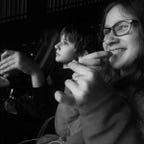A Happy Den of Weirdos: Hollerhouse
Hollerhouse makes me happy. I think that has to be the first thing I say, and probably the last as well. I’ll explain the reasons, but the pure emotional state is what I want to express at the outset. Brian Serway and friends have created a space that I like inhabiting, a place where I feel welcome and valued, a place where I encounter beauty and mystery and kindness, and also a place where I can be troubled and stirred without animosity or bitterness. Hollerhouse is a special place indeed.
Part of the happiness of Hollerhouse stems from the genial welcome Brian offers. Gallery owners can come across as badgers in their setts, protective and defensive and not particularly pleased to see you. And we shouldn’t blame them: these are sacred spaces, carefully curated and holding significant investments of money and time. Hollerhouse is certainly full of those investments, but instead of guarding them like a vault, Brian invites you to his home. Ask him about the various works: Who is the artist? How did you make this? What does this mean? What you’ll hear is not a sales pitch but a proud parent: he loves the works in the gallery, and he invites you to love them, too.
And there is much to love here. The gallery features Appalachian artists, and in doing so demonstrates the breadth of that term. For while much Appalachian art reflects the natural beauty of this place (and A Work of Art across the street has curated gorgeous images of our region for years), these artists let that environment seep into the imagination, percolate, and pour out in a dazzling array of styles and moods. Here, for example, is Brian Serway’s darkly mystical vision, with creatures both real and imagined against vistas that look like negative film images of the mountains we see every day. The familiar made strange, and the strange made strangely familiar: it’s a realm of wonder and fear and dark beauty that welcomes us to see Appalachia anew and enchanted.
Each artist here presents a unique Appalachian vision, and the stylistic differences surprise me each time. Alongside Serway’s work is that of Case Elledge, who brings a spare, pop art sensibility, often with comical touches. Through its bright palette and sharp lines, Elledge’s painting reveals displacement, desire, and hope, a rooted uprooting that disquiets our comfort while finding us at home. At another remove are Richard Graves’ faces, studies which distort and refract the human visage in order to show it more clearly. Highlighted, stretched, or divided, these are real faces that show real feelings, and more often than not turn out to be a mirror for ourselves.
Styles that vary wildly find a comfortable place next to each other at Hollerhouse. The vivid, swirling abstract forms of Marcy Parks’ paintings reveal an inner landscape as undulating, lovely, and dramatic as the hills of Appalachia. With bold colors and striking patterns, they are at once among the least representational and most personal pieces on display. And they hang next to the delightfully satirical work of Bubby Wade, an observer of Appalachian life whose comical images show, with an earnest whimsy, his love for home. They are at once funny and proud, and they fit the Hollerhouse vibe: imagination grounded in Appalachia, sprouting in multiple directions.
In addition to the mix of styles on display, the media vary as well: painting, pottery, fabric, comic book. And you can buy prints or stickers or pins or tee shirts or cards. It’s tempting to use a word like “eclectic” for this melange, but that’s too simple. Something binds all the work here together. Brian calls Hollerhouse a “den of weirdos,” and he’s right; but what makes this a den is not the strangeness but a shared love of making, of place, and of one another. Indeed, the affection of Brian for his artists is mirrored by their mutual affection: this is a place of support and encouragement, and when you walk into Hollerhouse you are welcomed to the pack. We’re all weirdos, after all, and we might as well enjoy one another’s company. I bet you’ll make new friends as they invite you to their imaginative worlds, and I bet you’ll find Hollerhouse a happy place.
